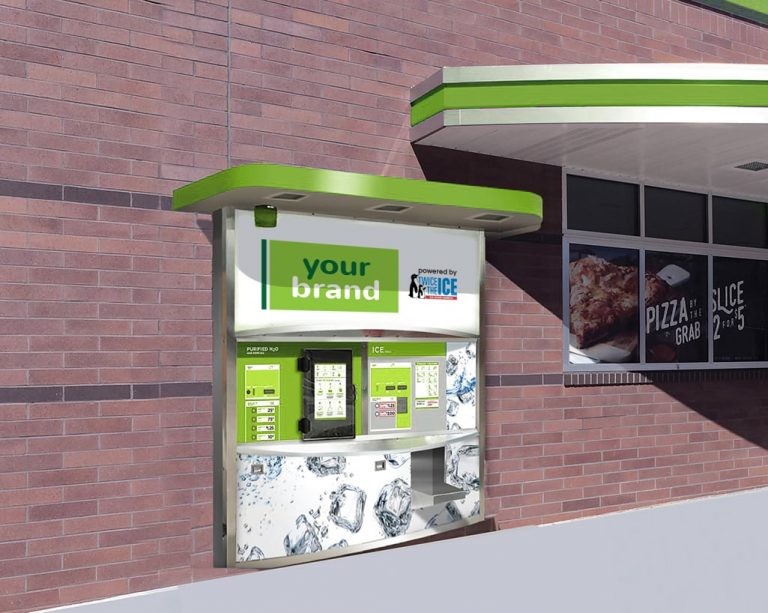Posted on: April 22, 2021 | Retailers
When it comes to ice-on-the-go, consumers and retailers have options, including bagged ice and ice vending machines. How ice is made, stored and dispensed affects quality as well as profit margins for business owners selling ice. So which ice is best? We compared traditional bagged ice and vending machine ice to see which type of ice is most sanitary, keeps customers happy, and keeps costs down.
Which Ice is Best: Bagged Ice vs Ice Vending Machine
Bagged Ice
According to the FDA, “The average American buys four bags of packaged ice each year, 80 percent of it between Memorial and Labor Day.” Bagged ice is produced in a factory and shipped where it’s needed, usually to grocery stores and convenience stores. Ice is considered a food item by the FDA, and it’s regulated in the same way as many food items. Bagged ice remains the most popular way for customers to get their ice, but it may not be the best type of ice. Bagged ice also presents challenges to business owners selling ice.
Sanitation
The FDA regulates vended ice and water as well as traditional bagged ice. However, vended ice reduces the risk of contamination between handlers; while traditional bagged ice is handled multiple times throughout the production and transportation process, customers are the only ones to handle vended ice.
In addition to production and logistics staff, multiple customers also come into contact with traditional bagged ice. This also increases the risk of damage to the bags of ice and increases product loss; as customers look for the bag they want, they may accidentally tear open other bags. The storage container for the bagged ice is also difficult to clean, and can easily accumulate mold and bacteria, which can contaminate the ice.
Cost
When comparing bagged ice vs commercial ice makers and vending machine ice, bagged ice from grocery stores or convenience stores is the most expensive, for both consumers and retailers. Theft is an ongoing problem with bagged ice, with about a 20 to 30% loss occurring when customers take a bag without paying, or only pay for one but take multiple bags. Preventing this means locking the ice chest and requiring employees to leave their post to unlock it, eating into productivity and creating inconvenience. Accounting for theft, maintenance of the ice bunker, and product loss, margins on bagged ice are comparatively low.
Quality
Bagged ice also has some challenges in quality compared to vending machine ice. Bags can tear during transport, or tear when customers sort through the ice bags to find the one they want. During especially hot days, the storage unit may struggle to maintain freezing temperatures, causing some ice to melt and then refreeze when temperatures drop during the night. This causes the bagged ice to freeze into a block, making it difficult to use.
Bagged ice also introduces stocking issues. Demand for ice increases during hot days and holidays, which can be difficult to account for. The limited capacity in the ice bunker creates a bottleneck, so ice may be out of stock when demand is highest.
Vending Machine Ice
Vending machine ice carries a number of benefits for both consumers and retailers. With an ice and water vending machine, the ice is made automatically on-site. There’s no need for shipping, monitoring, storage, or inventory. Customers can simply pay for the ice that they need at the vending machine. Ice House America ice machines can even be remotely monitored through a smartphone or other connected device.
Sanitation
Ice vending machines like Ice House America and Twice the Ice machines use a Twice Pure filtration system to eliminate impurities and microorganisms. Since the ice is made on-site and handled only by the consumer using the ice, there’s also a low risk of contamination through handling. The ice vending machines are also made to be easy to clean, so the inside components are free of bacteria.
Cost
There’s no transportation or storage costs associated with ice from vending machines, so the cost is significantly lower than bagged ice, for both retailers and consumers. With the ability to purchase ice in small or large quantities, it’s easy for individuals to get the ice they need. With no transportation or packaging costs, consumers also pay significantly less for the ice they need.
The cost of vending machine ice is also much lower for retailers. The average bag of ice costs store owners about $1.25 per bag, while the comparable costs of vending machine ice is $0.25 to $0.30 per bag. The result is a win-win; consumers pay less while retailers make more.
Quality
While bagged ice may thaw and refreeze as temperatures swing, creating unwieldy ice blocks, vending machines create ice as it’s needed, so there’s no opportunity for refreezing. Since the ice is contained in the unit, there’s also no risk of product loss or contamination due to handling. Finally, there’s an unending supply of ice as long as the machine remains connected to a water line, so there’s little risk of running out of ice when demand is highest.
Ice vending machines give consumers and retailers a number of advantages, including better quality and increased profit margins. If you’re considering upgrading your ice system to get ready for the summer, take a look at ice vending machine models that can fit your business.
Retailer's Guide to Ice & Water Vending
Traditional bagged ice hasn’t changed in decades. Download the guide to learn how ice and water vending is better for consumers, store managers and retail chain owners.
Download the Guide


